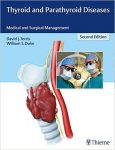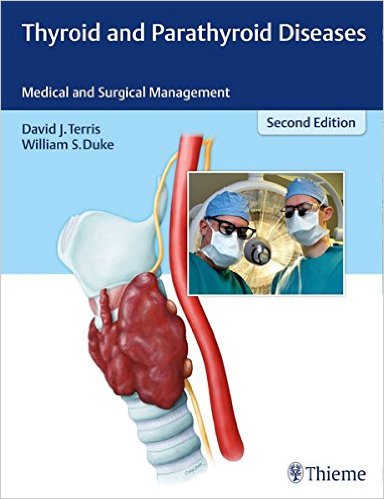 Editors: David J. Terris, MD; and William S. Duke, MD
Editors: David J. Terris, MD; and William S. Duke, MD
Publisher: Thieme – 282 pages
Book Review by: Nano Khilnani
Thyroid cancer is the most rapidly increasing cancer in the in the United States and Europe, the sixth most common cancer among women, and the second most common cancer in women under 40, according to Dr. Orlo Clark, who wrote the Foreword for this book. He also writes that thyroid nodules are common and palpable nodules occur in about four percent of the general population.
The current edition of this book was released in 2016. It came into being because like in many medical specialties, much research is being done, and new information has emerged since the first edition appeared in 2008, even as that edition introduced cutting-edge advances and novel techniques in thyroid and parathyroid surgery.
This new edition presents well-organized and systematically laid-out fresh information pertaining to: imaging, indications for operation, molecular biology, physiology, new medical and surgical treatments, and much more.
Fifty-eight specialists in otolaryngology–head and neck surgery, as well as in anatomic pathology, cell biology, endocrinology and metabolism, endocrine surgery, hematology, neuroradiology, oncology, and thyroid and parathyroid surgery, authored the 33 chapters of this excellent, wide-ranging book on various aspects of the thyroid-parathyroid system.
The two editors named above are thyroid and parathyroid surgeons, as are some of the other content contributors to this book. The writers are mainly from the United States, except nine from five other countries: Hong Kong, India, Italy, Russia, and the United Kingdom. They have extensive experience in the surgical and medical management of thyroid and parathyroid diseases.
Dr. Clark points out that currently the controversy continues regarding the extent of thyroidectomy and node resection for low-risk papillary thyroid cancers, and even for whether thyroid resection is necessary for small (less than 1 centimeter) tumors.
In 1850, about 40 percent of those who underwent thyroidectomy, died. Today that number is less than one percent. As the knowledge and understanding of the complex pathophysiology of the thyroid and parathyroid glands has grown, experience has been accumulated, and surgical skills have sharpened, minimally invasive procedures have become routine. Currently, even remote access surgery is being performed by some experts in this specialty.
With the titles of the 33 chapters of this book too numerous to mention here, we name below its six Parts to give you an overview of what is covered in this textbook:
- Part 1: Anatomy, Physiology, and Pathology of the Thyroid Compartment
- Part 2: Thyroid Diseases
- Part 3: Surgical Management of Thyroid Diseases
- Part 4: Parathyroid Diseases
- Part 5: Surgical Management of Parathyroid Diseases
- Part 6: Special Topics
Several new concepts and topics are introduced in this new edition, including:
- Emerging nerve monitoring techniques
- Evolving central neck imaging
- Modern advances in the management of thyroid disease
- Modern application of rapid intra-operative assessment of parathyroid hormone levels
- Remote access endocrine surgery
To provide you an overview of the topics covered in a typical chapter, let us take a look at chapter 14, Minimally Invasive Thyroid Surgery, in Part 3, Surgical Management f Thyroid Diseases.
All chapters typically contain an Introduction, a Conclusion, and a list of References, with discussions of various topics and subtopics sandwiched in between, and presentations enhanced with various types of images and tables.
Introduction in chapter 14 summarizes the advantages of minimally invasive thyroid surgery versus conventional surgery. Among these are: carefully selected patients, shorter incisions that reduce cosmetic impact, decreased postoperative pain, the omission of postoperative drains, speedy recovery process, improved patient’s postoperative experience.
The two main types are: minimally-invasive nonedoscopic thyroidectomy (MINET), and minimally-invasive video-assisted thyroidectomy (MIVET)
Topics and subtopics are:
- Patient Selection
- Operative Steps
- Preparation of the Operative Space
- Division of the Main Thyroid Vessels
- Identification of the Important Structures of the Region: The Recurrent Laryngeal Nerve and the Parathyroids
- Extraction of the Thyroid Lobe Outside the Neck and Completion of the Lobectomy
- Access Closure
- Results and Outcome
- Postoperative Care
- Management of Procedure-Specific Complications
References: Eight sources of information, further reading on topics related to chapter title.
This is an outstanding resource on the surgical treatment and medical management of thyroid and parathyroid diseases, produced by an experienced and knowledgeable team of experts.
Editors:
David J. Terris, MD, FACS is Professor of Otolaryngology – Head and Neck Surgery, and Surgical Director of the GRU Thyroid and Parathyroid Center at Georgia Regents University in Augusta, Georgia.
William S. Duke, MD is Assistant Professor of Otolaryngology – Head and Neck Surgery, and Associate Surgical Director of the GRU Thyroid and Parathyroid Center at Georgia Regents University in Augusta, Georgia.
Foreword:
Orlo H. Clark, MD, FACS is Emeritus Professor of Surgery at the University of California- San Francisco, in San Francisco, California.







